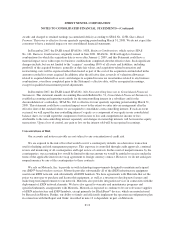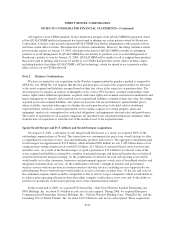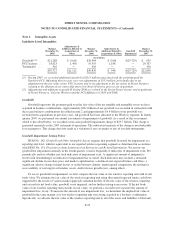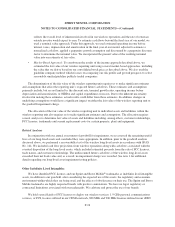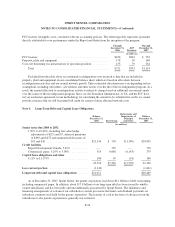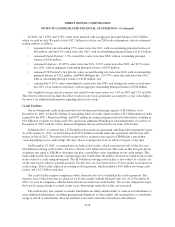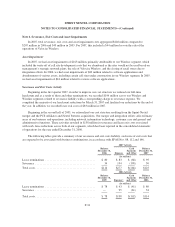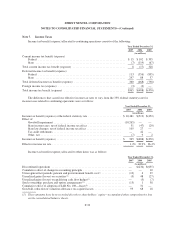Sprint - Nextel 2007 Annual Report Download - page 108
Download and view the complete annual report
Please find page 108 of the 2007 Sprint - Nextel annual report below. You can navigate through the pages in the report by either clicking on the pages listed below, or by using the keyword search tool below to find specific information within the annual report.SPRINT NEXTEL CORPORATION
NOTES TO CONSOLIDATED FINANCIAL STATEMENTS—(Continued)
including any unrecognized intangible assets, in a hypothetical calculation that would yield the implied fair value
of goodwill. If the implied fair value of goodwill is less than the goodwill recorded on our balance sheet, we
record an impairment charge for the difference.
2007 Goodwill Assessment
During the period from our annual 2006 goodwill impairment assessment through third quarter 2007, we
periodically analyzed whether any indicators of impairment had occurred. As part of these periodic analyses, we
derived the estimated equity value of the wireless reporting unit, which we then compared to its net book value.
Specifically, we reduced our stock price by the estimated value per share of our wireline reporting unit and then
added a control premium, as permitted by FASB guidance, to determine an estimate of the equity value of the
wireless reporting unit. As the estimated fair value of the wireless reporting unit was higher than its net book
value during each of these periods, no additional testing was necessary.
In fourth quarter 2007, we conducted our annual assessment of goodwill for impairment. During this
quarter, we experienced a sustained, significant decline in our stock price. The reduced market capitalization
reflected the Wireless segment’s lower than expected performance, due in large part to fewer than expected net
subscriber additions. In previous periods, we had expected that we would be able to produce net post-paid
subscriber additions during 2007. In the fourth quarter, we reported a loss of 683,000 post-paid subscribers which
was the most post-paid subscribers we had ever lost in a quarter.
We also updated our forecasted cash flows of the wireless reporting unit during the fourth quarter. This
update considered current economic conditions and trends; estimated future operating results, our views of
growth rates, anticipated future economic and regulatory conditions; and the availability of necessary technology,
network infrastructure, handsets and other devices. Several factors led to a reduction in forecasted cash flows,
including, among others, our ability to attract and retain subscribers, particularly subscribers of our iDEN based
services, in a highly competitive environment; expected reductions in voice revenue per subscriber; the costs of
acquiring subscribers; and the costs of operating our wireless networks.
Based on the results of our annual assessment of goodwill for impairment, the net book value of the wireless
reporting unit exceeded its fair value. Therefore, we performed the second step of the impairment test to
determine the implied fair value of goodwill. Specifically, we hypothetically allocated the fair value of the
wireless reporting unit as determined in the first step to our recognized and unrecognized net assets, including
allocations to intangible assets such as customer relationships, FCC licenses and trade names. Such items had fair
values substantially in excess of current book values. The resulting implied goodwill was $935 million;
accordingly, we reduced the goodwill recorded prior to this assessment by $29.7 billion to write our goodwill
down to the implied goodwill amount as of December 31, 2007. The $29.7 billion goodwill impairment charge is
our best estimate of the goodwill charge as of December 31, 2007. Any adjustment to that estimated charge
resulting from the completion of the measurement of the impairment loss will be recognized in the first quarter
2008. The allocation discussed above is performed only for purposes of assessing goodwill for impairment;
accordingly we do not adjust the net book value of the assets and liabilities on our consolidated balance sheet
other than goodwill as a result of this process.
Methodologies, Estimates, and Assumptions
We performed extensive valuation analyses, utilizing both income and market approaches, in our goodwill
assessment process. The following describes the valuation methodologies used to derive the fair value of the
wireless reporting unit.
•Income Approach: To determine fair value, we discounted the expected cash flows of the wireless
reporting unit. The discount rate used represents the estimated weighted average cost of capital, which
F-23








